In this week’s digest we are thrilled to doff our caps to some friends from across the pond. In particular we honor Alison Britton’s long role as a mentor, who provides us with a fitting pun to headline this post. All the artists featured here have been influenced and advanced, one way or another, by Britton as curator, critic, writer, educator and maker. And, we might add, our editor was also a beneficiary, who met her in 1974 at Royal College of Art, London where both were students.
Ken Eastman’s ‘Wanton Chase’
Boston-Glenn Adamson, in his essay that accompanies the solo show by Ken Eastman at the Lucy Lacoste Gallery, (January 16 – February 6, 2021), quotes the artist’s explanation of the exhibition title, The Border Country, “[this] is where I live, and the border is something I’m aware of and often cross.” Adamson continues:
“Back in 1989, Allison Britton wrote of an Eastman pot: “It’s pleasures are abstract, it provides a place for the eye to wander in.” That reminds me in turn of another British artist, William Hogarth, writing in his Analysis of Beauty (1753) of compositions that “lead the eye a wanton kind of chase.” Other connections come to mind, too: the sculpture of Barbara Hepworth, the architecture of Frank Gehry, the choreography of Martha Graham, the tailoring of Cristobal Balenciaga. All these figures share Eastman’s particular form of genius, to pitch a curve in space just so, and meet it with another, and another, and another, each shape compounding the intelligence of the whole. Yet Eastman has something going for him that none of these others do (Britton excepted, of course): the affordances of pottery. Uniquely among art forms, it allows for a dialogue between inside and out. The relationship between a vessel’s interior and its exterior topologies has no exact parallel: it is not simply a repetition, nor a mirroring, nor a molding, but its own special kind of counterpoint”.
We might add that Eastman, an incrementalist, who has for years followed a closely defined vocabulary in form and surface, has recently, without many obvious changes, brought a new sensibility. Surface and form is seamlessly integrated and the borders between colors are blended so subtly that they drift into each another like mist. This is maturity at its best.
The Thing Allison Britton is Seeing
London—Tommaso Corvi-Mora presented a relaxed, elegant solo exhibition (September 17-October 31, 2020) of work by Alison Britton, her first at this gallery. Britton is one of the most important and influential ceramic artists in the UK, a career that began in the mid-70’s. A graduate of the Royal College of Art in London, she belonged to a group of artists who were identified as “The New Ceramics” movement, bringing the medium into the Postmodern era.
Her vessels questioned Bernard Leach’s “standard” in favor of a more complex and nuanced approach. Alison Britton’s practice has remained focused on the vessel, exploring its features both formal and conceptual. She has taught at the RCA for decades and has a distinguished career as both a critic and theorist. “Seeing Things”, a collection of her writings on art, craft and design, was published by Occasional Papers in 2013. Her work has been exhibited widely in the UK and abroad.
Learn more about Britton in Cfile
Jennifer Lee‘s Geological Elegance
Cambridge, UK—Jennifer Lee: the potter’s space, at Kettle’s Yard, is Lee’s first public solo show in the UK since 1994. It includes 40 pots that date back to her Royal College of Art degree show in 1983, and up to 2019, with the inclusion of three new pieces made in the run-up to the show.
Wallpaper writes that “Jennifer Lee is reticent about her latest exhibition being referred to as a retrospective. The pots represent just a handful of key moments in Lee’s prolific career, and in this sense, a synopsis might be a better fit”.Collected over a 20-year period, the pots date as far back as 1990 as Lee’s explorations are a patient and deepening art, and “in turn, each pot grows slowly, hand built from the base up, only finally expressing its entire beauty when it emerges from the kiln.”
Part of the exhibition has been designed by architect Jamie Fobert. It is masterful, an egalitarian exposition of vessels on large platforms, where the pots have equal stature, buzz, hum and slowly rotate:
“The pieces are loosely arranged chronologically across a low table that has been covered in a delicate layer of fine plaster. The table’s height is based on the level of the workbench in Lee’s south London studio, and a band of putty coloured paintwork, that runs around the walls to represent the height of the studio while also lowering the eye to the work, also echoes her workspace.
Eschewing a vitrine, which Lee sees as a kind of retrofitted glazing, the vessels are presented open-air. ‘Because there’s no glaze on the work, to actually put a piece of glass between you and the work is almost like giving it another dimension, another texture and it’s taking away from what I want the work to look like,’ says Lee. ‘It’s almost glazing it.’“
View the catalog here.
The Embodied Architecture of Sara Flynn
London-In her recent solo show at Erskine, Hall & Coe, (October 6-9, 2020), Sara Flynn builds upon her 2018 works, each vessel characterized by sensual convexity, which when grouped pour into one another in an ebb and flow of negative space. Dame Magdalene Odundo, OBE, writes of these forms:
“Sara Flynn has been introducing us to forms and vessels that are made on a wheel. They are then deconstructed and reconstructed as if they were conceived as dwellings for a neighbourhood in which the vessels might be inhabited by individuals, couples or families. The forms are not simply altered to create niches and corners that make you hone in on the detail of the vessel: they relate to each other like dwellings or architecture that spontaneously grows outwards and spreads instantaneously like the favelas, sheltered adobe clusters in deserts or hillside granaries of Mali.”
Professor Simon Oldin views them in a slightly different context:
“The vessels in this exhibition take forward Sara’s interest in the quiet radical nudge of the unanticipated line. On the face of it, a vessel ought to pay homage to order and symmetry and usefulness, but her vessels resound with the offbeat curve, the rim that dips, the foot that flattens.The slender surface of an elongated form is pushed in on the side; deep scars rundown. Sinuous curves are embedded into the walls of some works, enhancing the vessel’s sculptural potencies. Pairs of pots nod urbanely to each other, lean in as if in conversation. Her lines are sharp and soft, carved and dimpled, the volumes squeezed and fulsome, sometimes both in the same work. These are works of order, contradiction and peerless poise. They seem to be both totemic and some how introvert, always self-contained.“
Explore the exhibition catalogue and essays here.
Learn more about the artist in Cfile.
A Gareth Mason Archeological Dig
New York—Jason Jacques Gallery presented its first retrospective exhibition of the works of Gareth Mason in 33 Pots: A Decade in Cahoots (October 2020). Known for his unconventional approach—often irreverent to the discipline itself––Mason’s works capture a cosmic presence. As art historian and curator Glenn Adamson argued, just one pot “may contain as many ideas as a whole archaeological pit.” It is in this pit where Mason continues to find capacious landscapes:
“Mud and Fire harbour such bewitchment—so deep is their reach, so tight is their bond—that their under-currents and potentialities are set to agitate my inner workings for the rest of my days.”
From the Gallery:
“Mason, who in recent years has declared himself a sensualist, takes the world in stride and embodies the yearning, in every human person, to experience Awe with a capital A. More poignantly, his work rewards observation, thought, and understanding. It encapsulates the human ability to feel awe in every experience, from the totally mundane to the absolutely sublime.”
Explore the exhibition catalogue here.
Learn more about the artist in Cfile.
Edmund de Waal, Begging to be Held
London. Gagosian Gallery presents some winter pots by Edmund de Waal. The exhibition is a first in sixteen years, in which de Waal presented individual works not created alongside a larger installation. During a time of physical and social isolation, and where touch is taboo, de Waal’s works in some winter pots invite an intimate, tactile experience; each form is unique and yet familiar: bowl, dish, and jar. De Waal explains:
“I made these pots in lockdown during the spring and early summer. I was alone in my studio and silent and I needed to make vessels to touch and hold, to pass on. I needed to return to what I know—the bowl, the open dish, the lidded jar. When you pick them up you will find the places where I have marked and moved the soft clay. Some of these pots are broken and patched on their rims with folded lead and gold; others are mended with gold lacquer. Some hold shards of porcelain.
In the studio I had two old Chinese bowls from the Song dynasty. One was patched on the rim with iron. The other had a beautiful thin golden thread running from the rim, repaired using the Japanese art of kintsugi. Kintsugi is not an art of erasure—the invisible mend, the erasing of a mistake—but rather a way of marking loss. Both these bowls were central to the making of this work.”
While we’ve all experienced some level of loss during this time, de Waal’s winter pots encourage us to deepen our ability to return to and revel in what we hold dear. The exhibition has been installed so that it can also be seen from the street. This adds the outdoor chill of the season to viewing the art.
Enjoy the discussion between Gallery artists, Edmund de Waal and Theaster Gates.
Lean more about the artist in Cfile.
Bouke de Vries’ Smashing Dinner
Hartford, CT–After several years of touring European venues, we caught up with Bouke de Vries’ much traveled epic. War and Pieces on its American tour at the Wadsworth Atheneum Museum of Art and it approaches the zenith of Tolstoy’s masterpiece via an vast 26-foot installation “inspired by the sophisticated figural centerpieces that decorated 18th-century European banqueting tables.” The museum writes:
“Displayed during the dessert course on special occasions, these figures, first made of sugar and later made increasingly of porcelain, told stories or conveyed political messages to the diners.“
Bouke de Vries draws on such traditions in the modern centerpiece, arranged around the mushroom cloud from a nuclear explosion whose force appears to have turned the entire table into a wasteland. Battle rages across a heap of porcelain shards, old and new, fought by myriad miniature figures with conventional arms. Jesus on the cross and the Chinese Buddhist goddess of compassion, Guanyin, watch over the death and destruction. Brightly-colored contemporary plastic toys—indestructible symbols of our own toxic times—contrast vividly with the pure white of the porcelain and sugar.”
Learn more about the artist in Cfile.


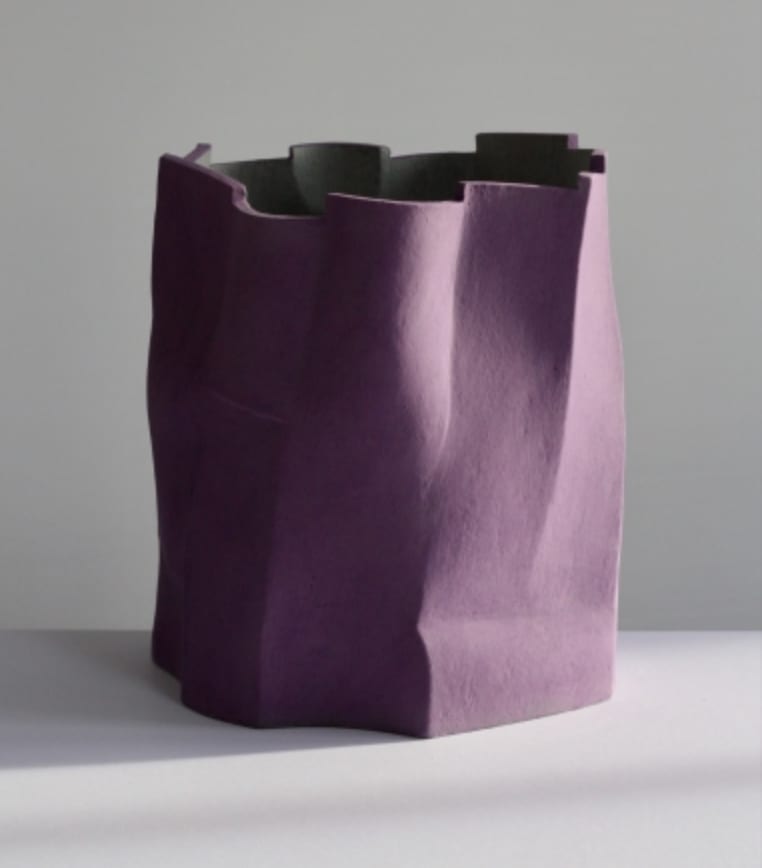
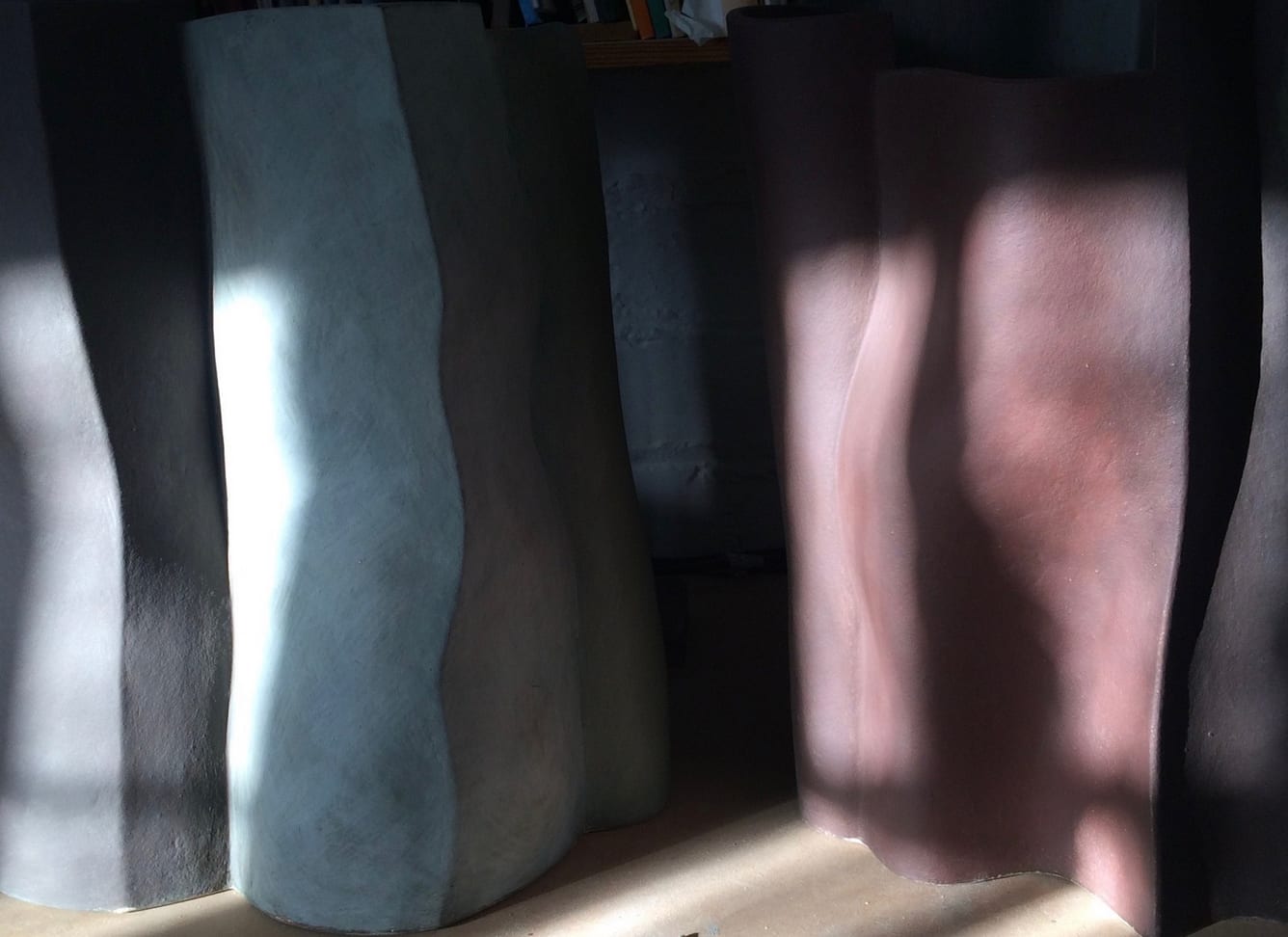

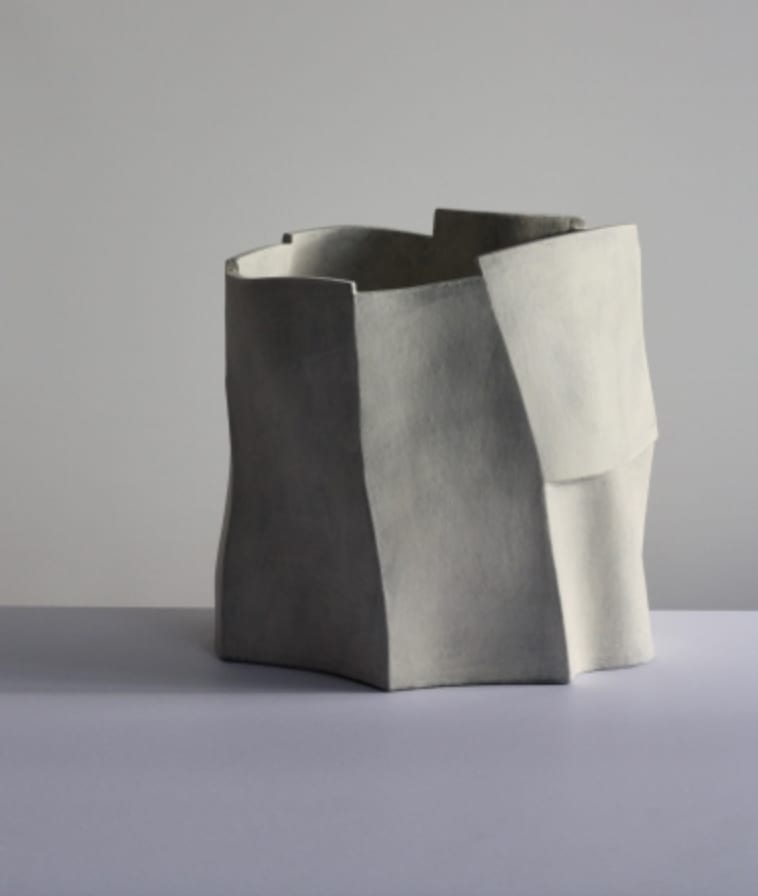
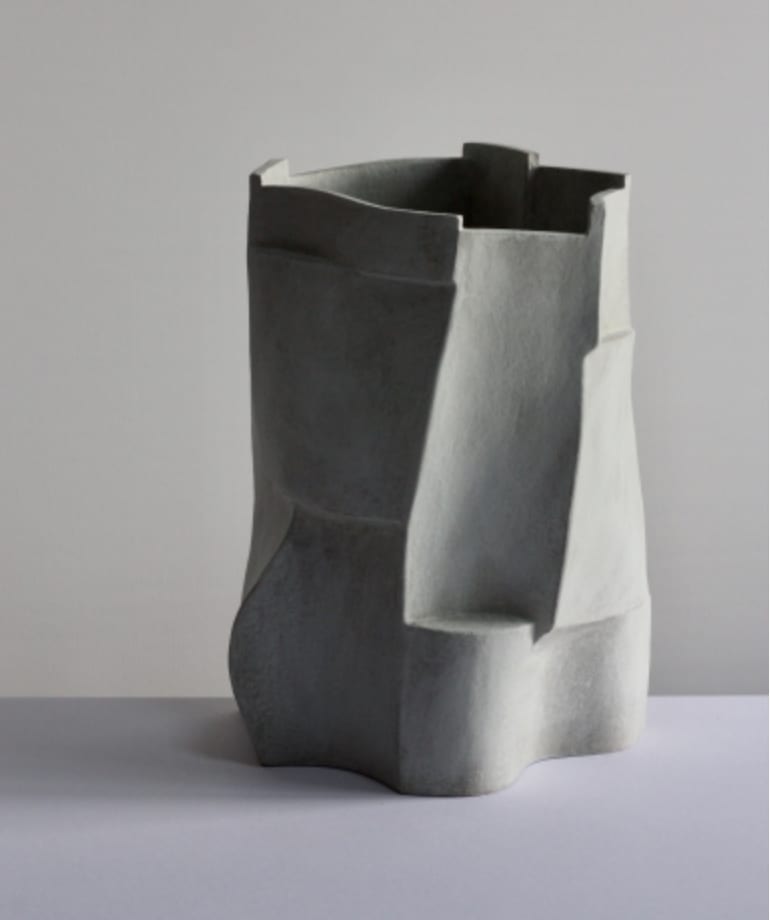
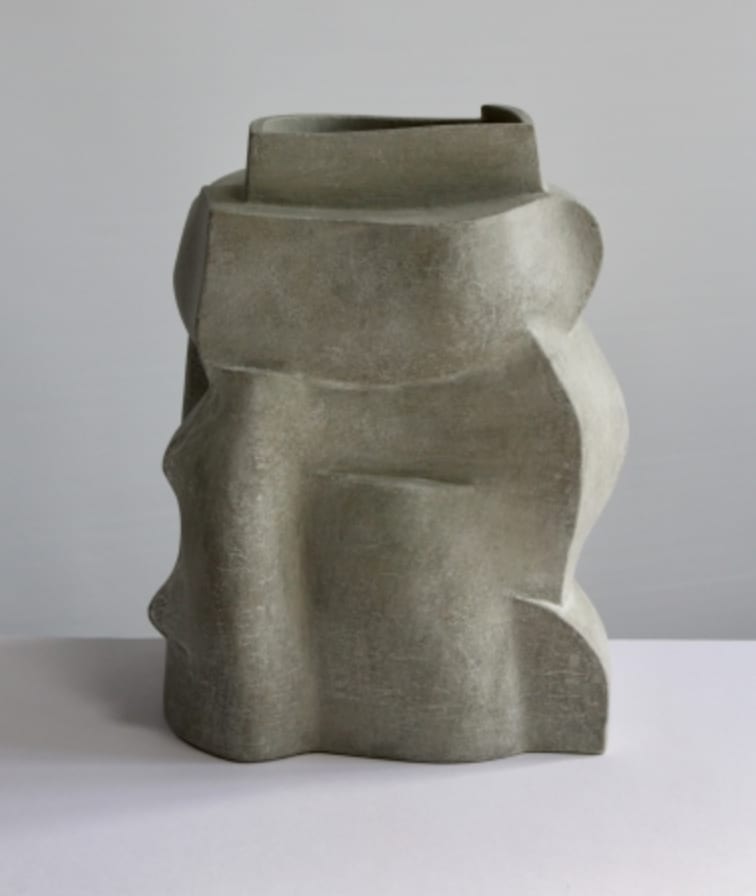


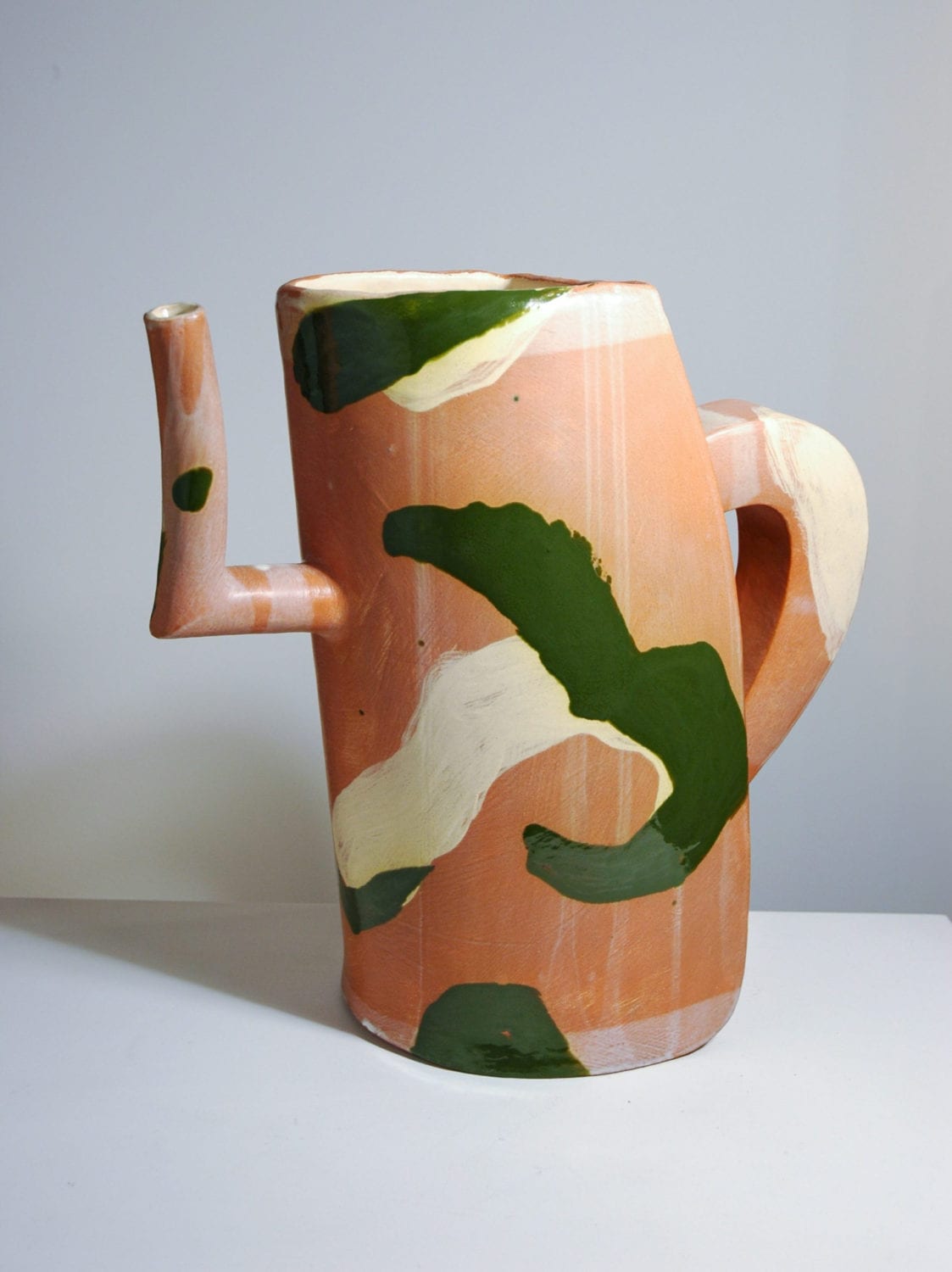
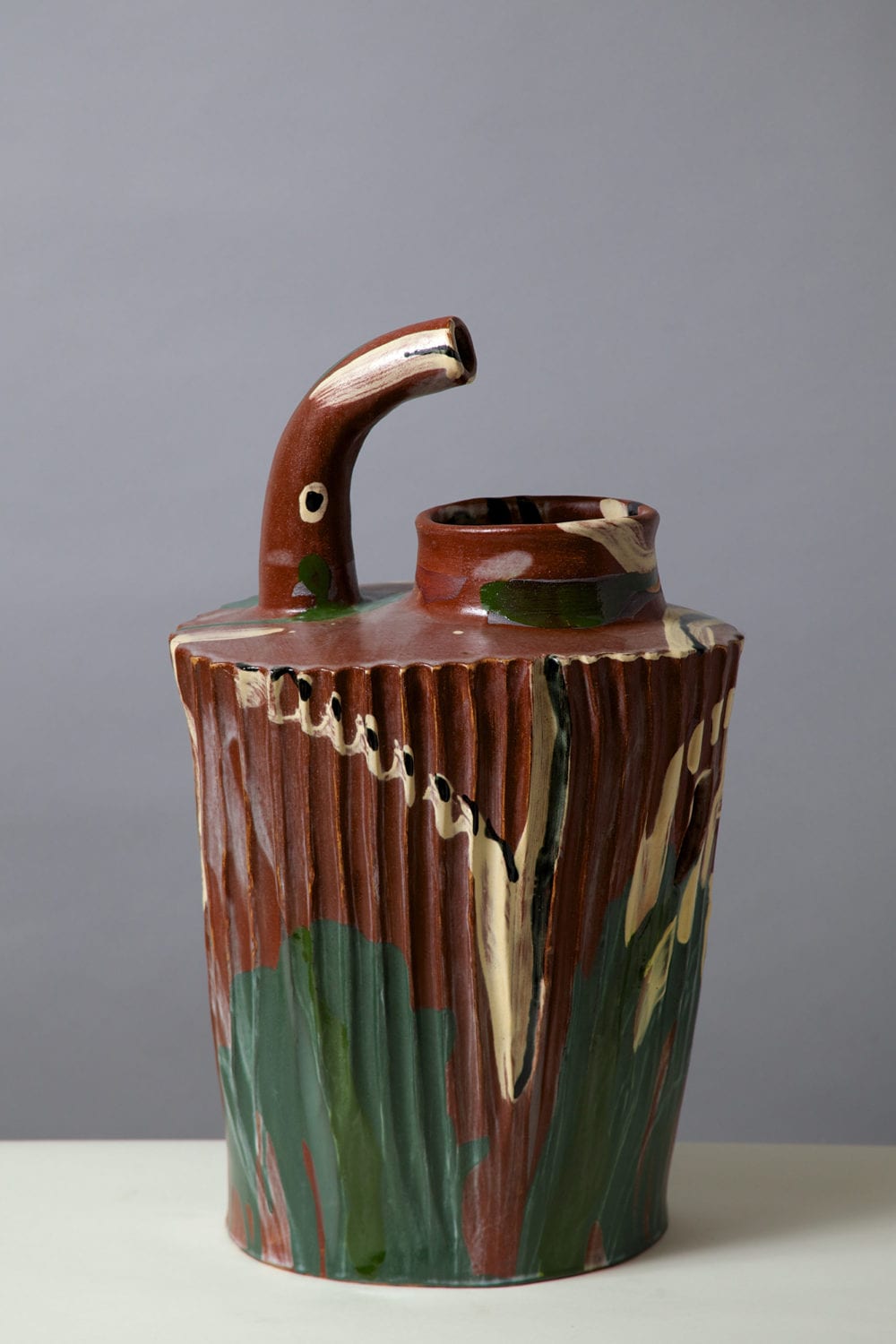


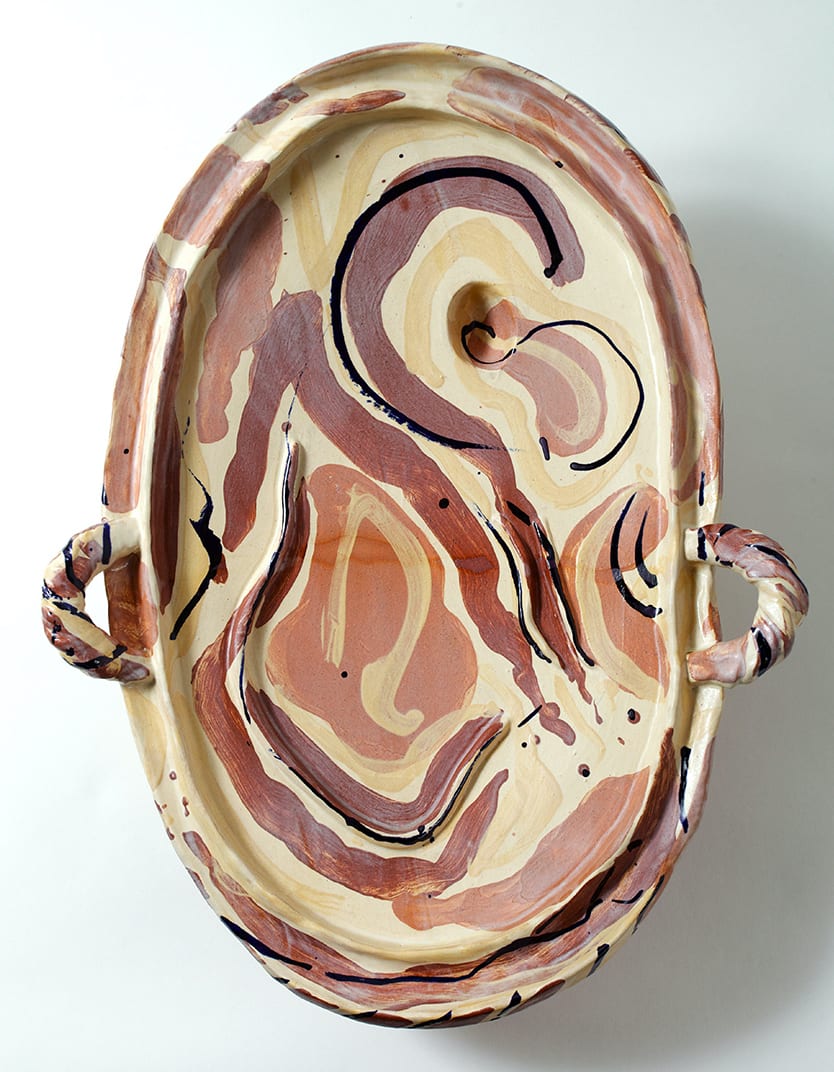





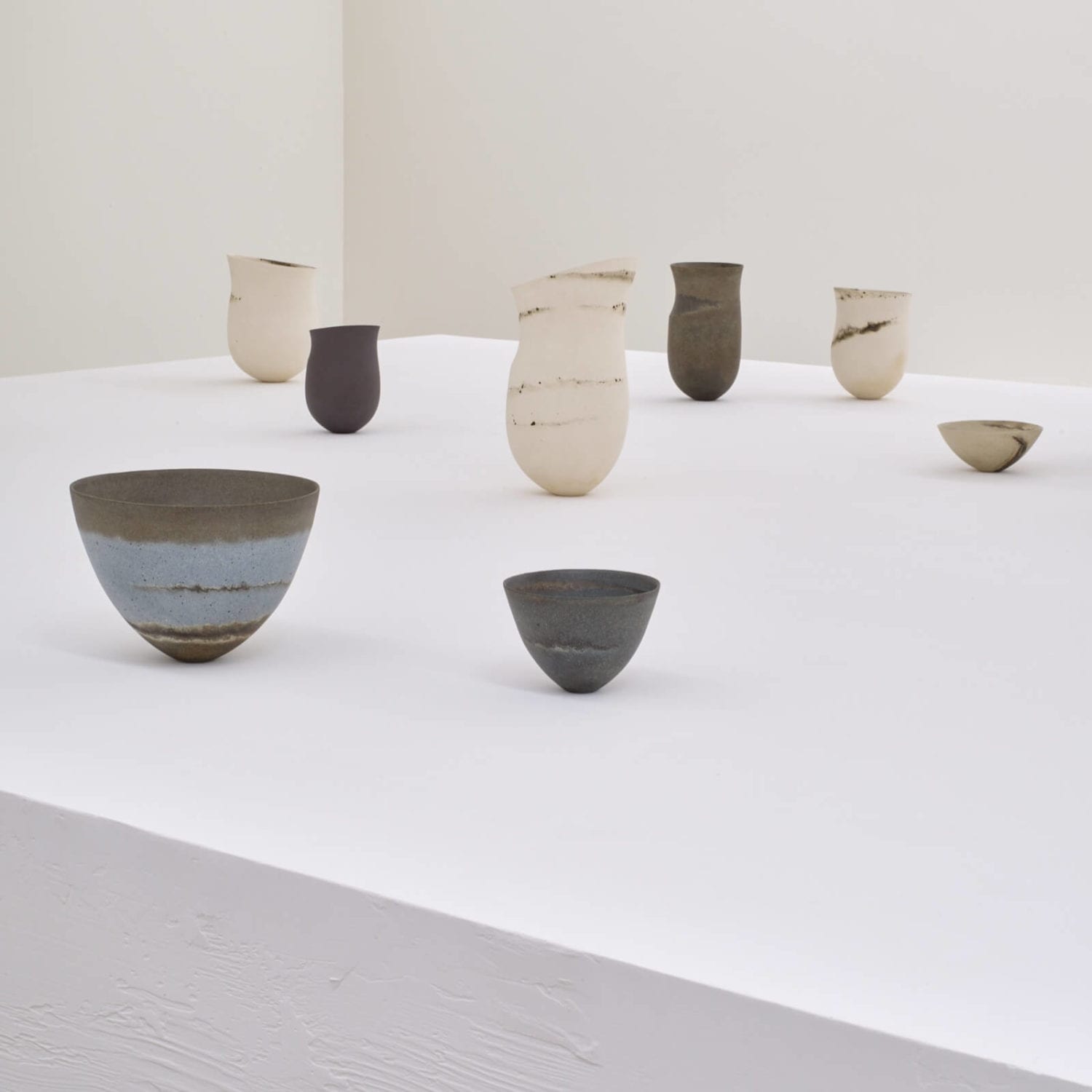

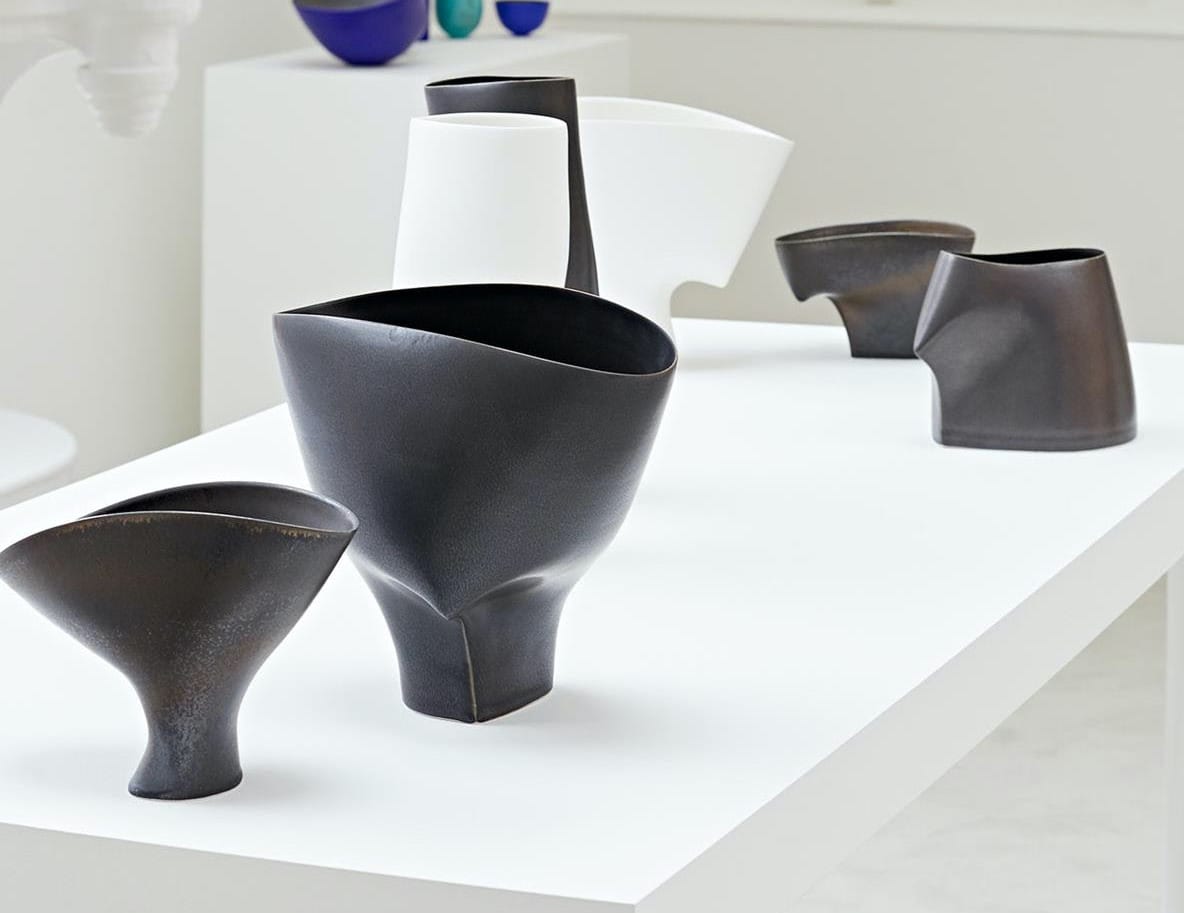



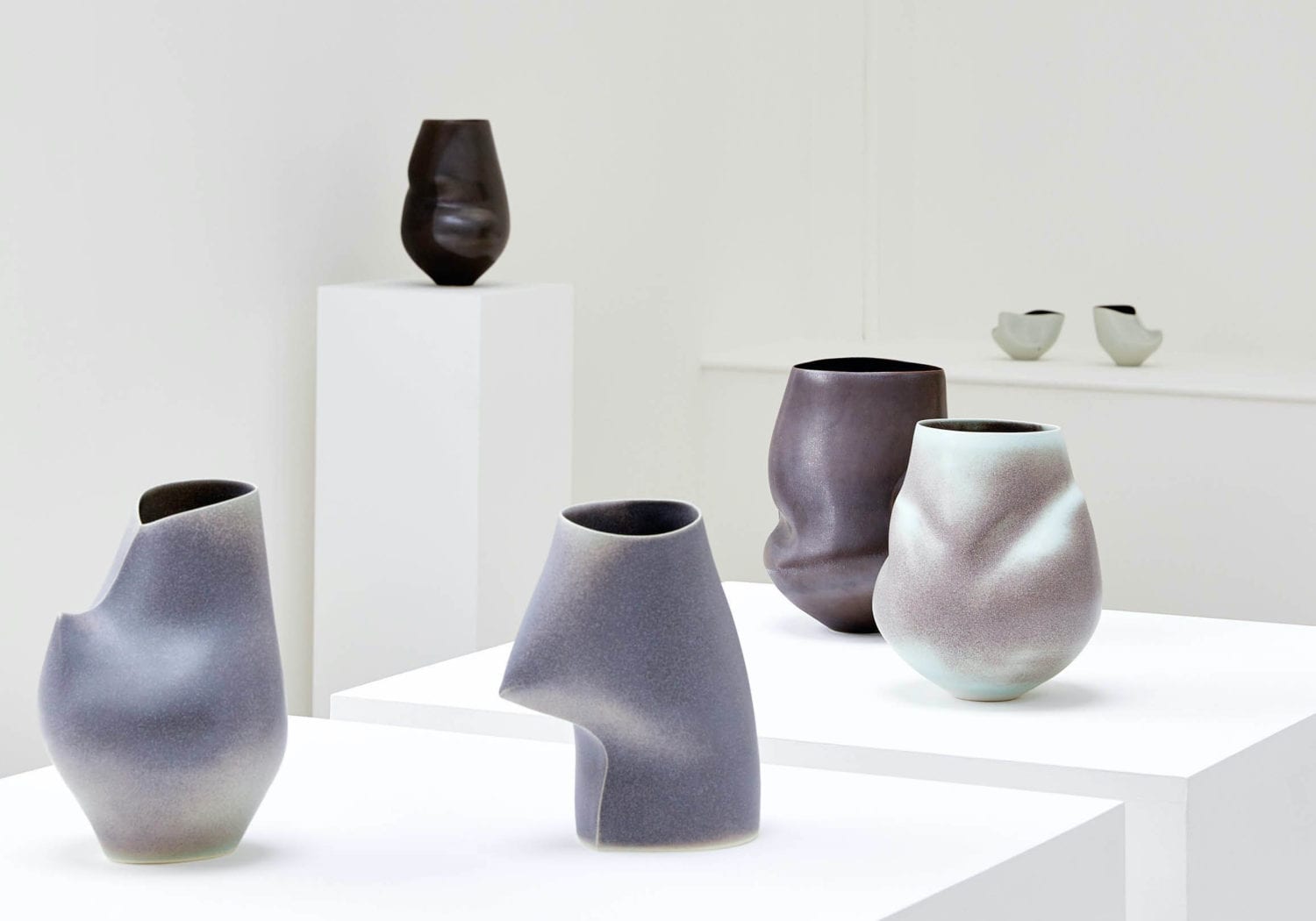

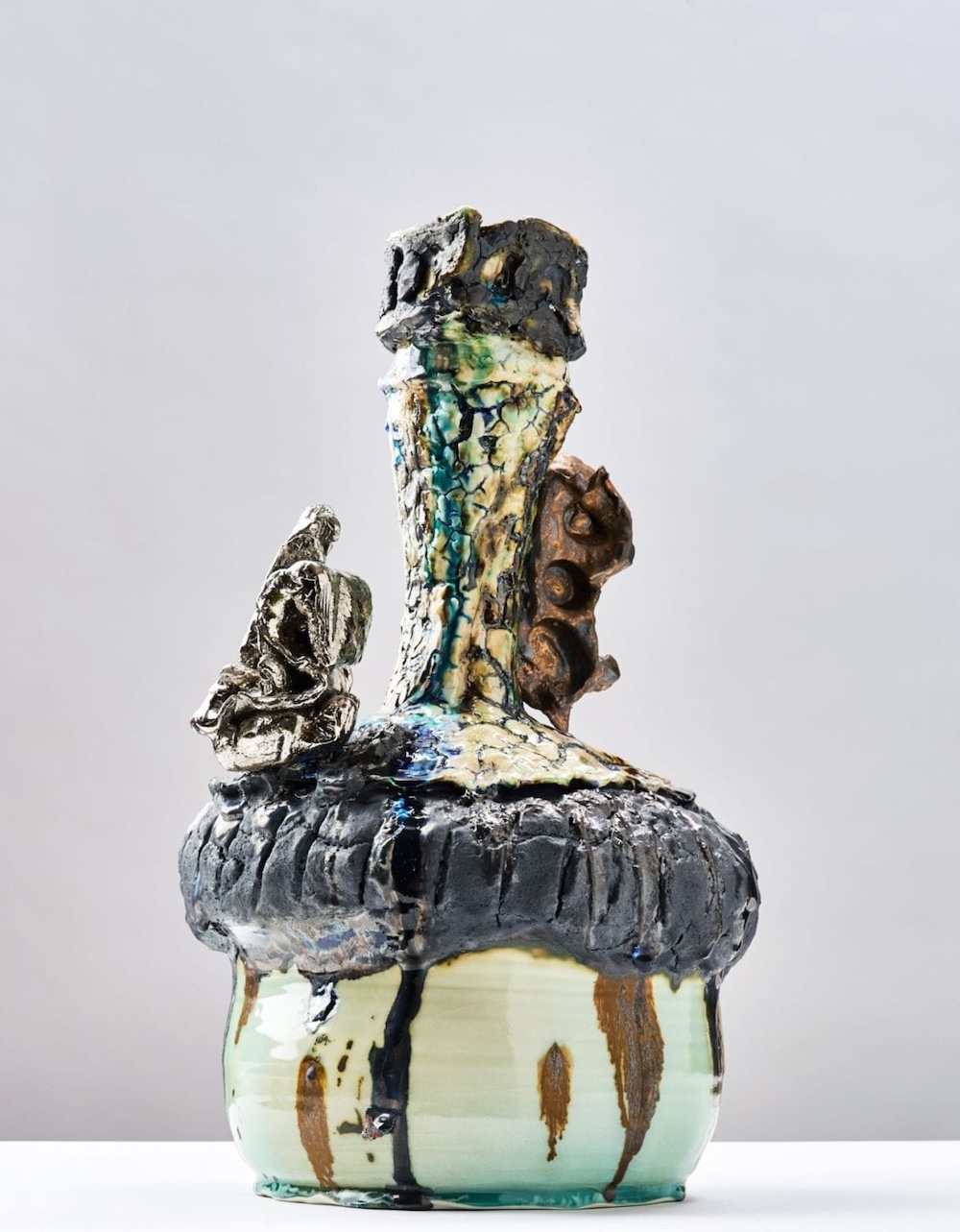

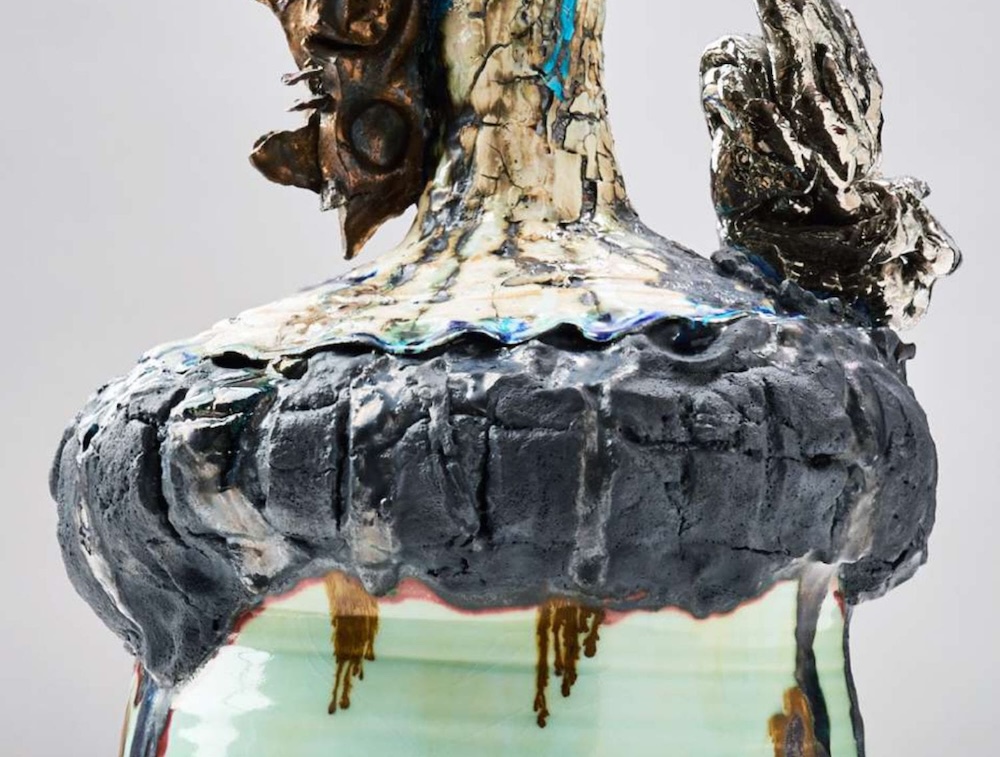
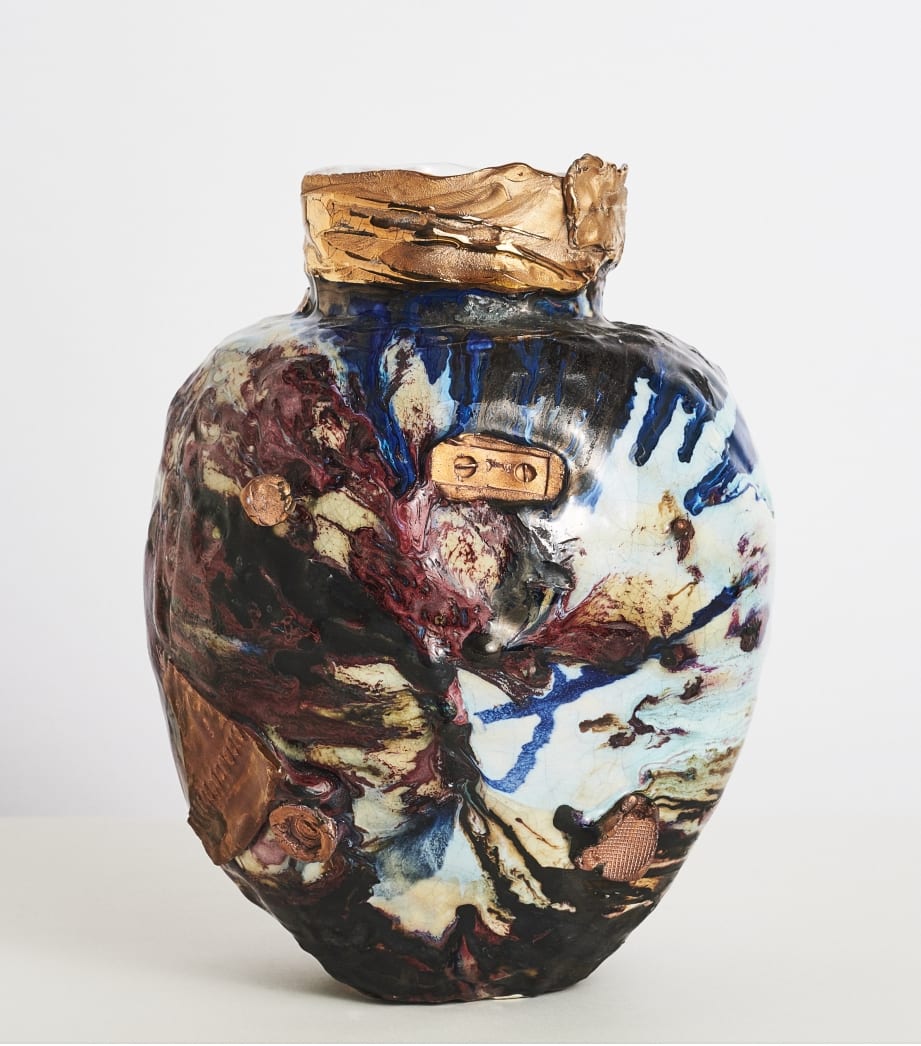
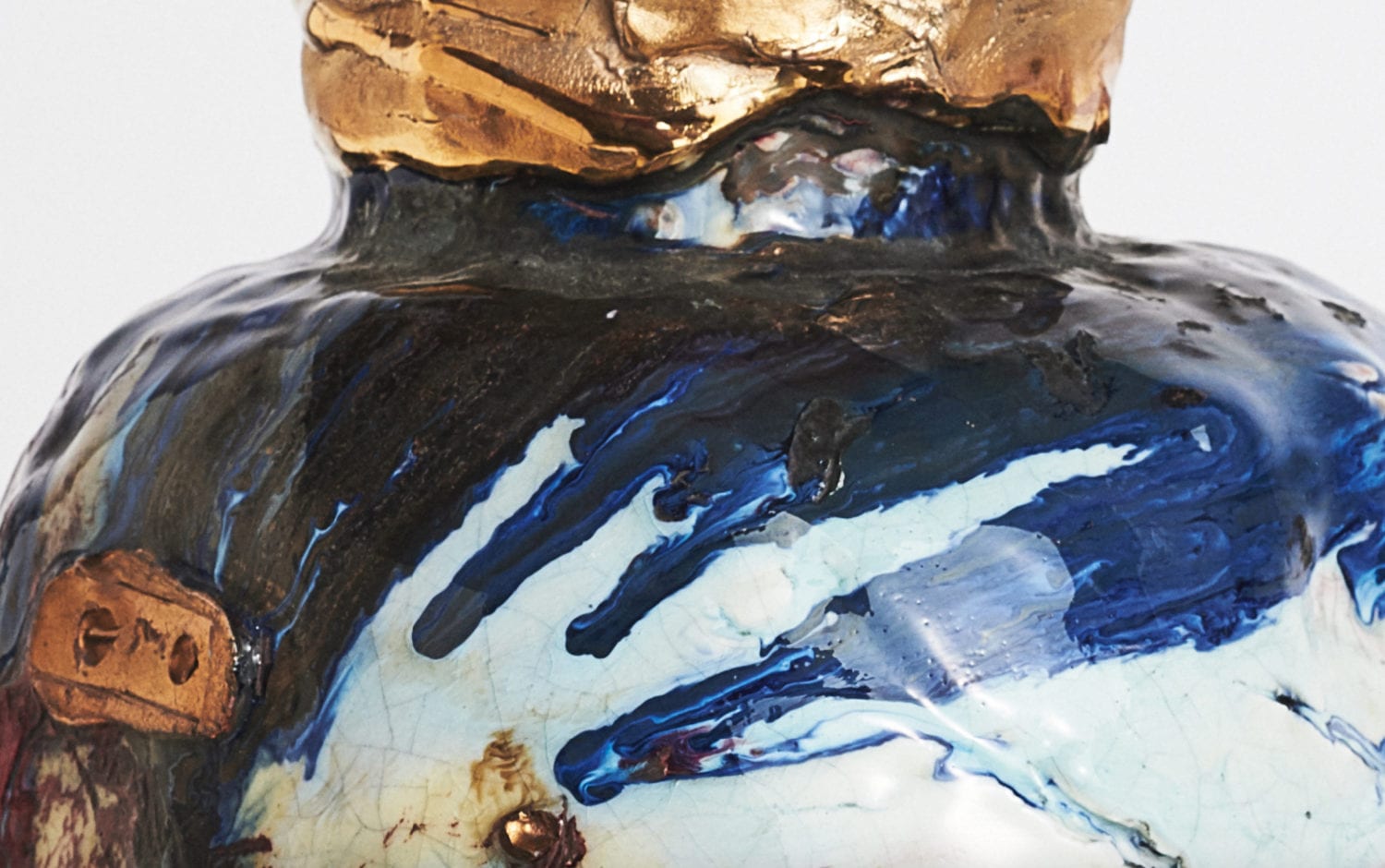

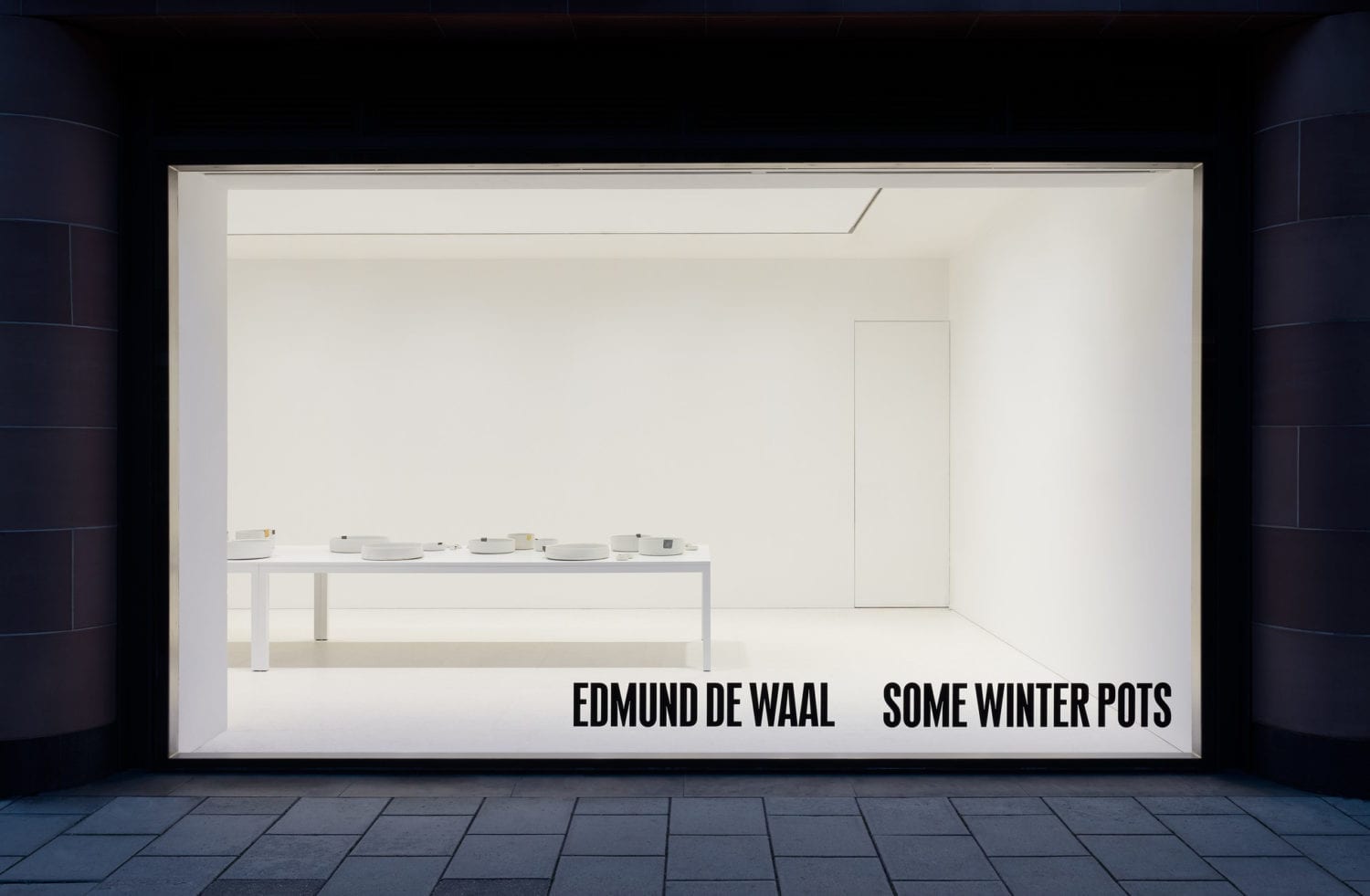
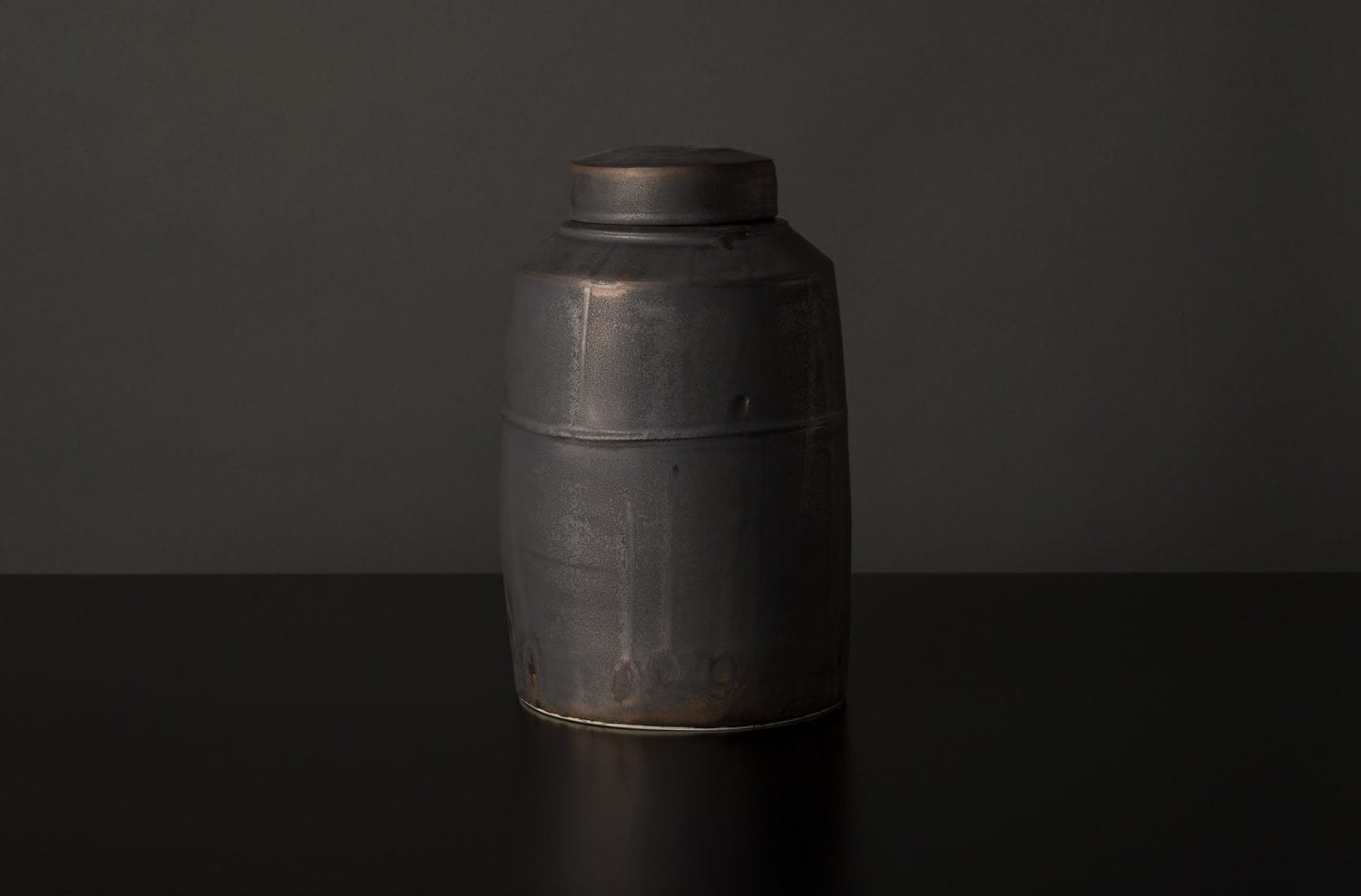
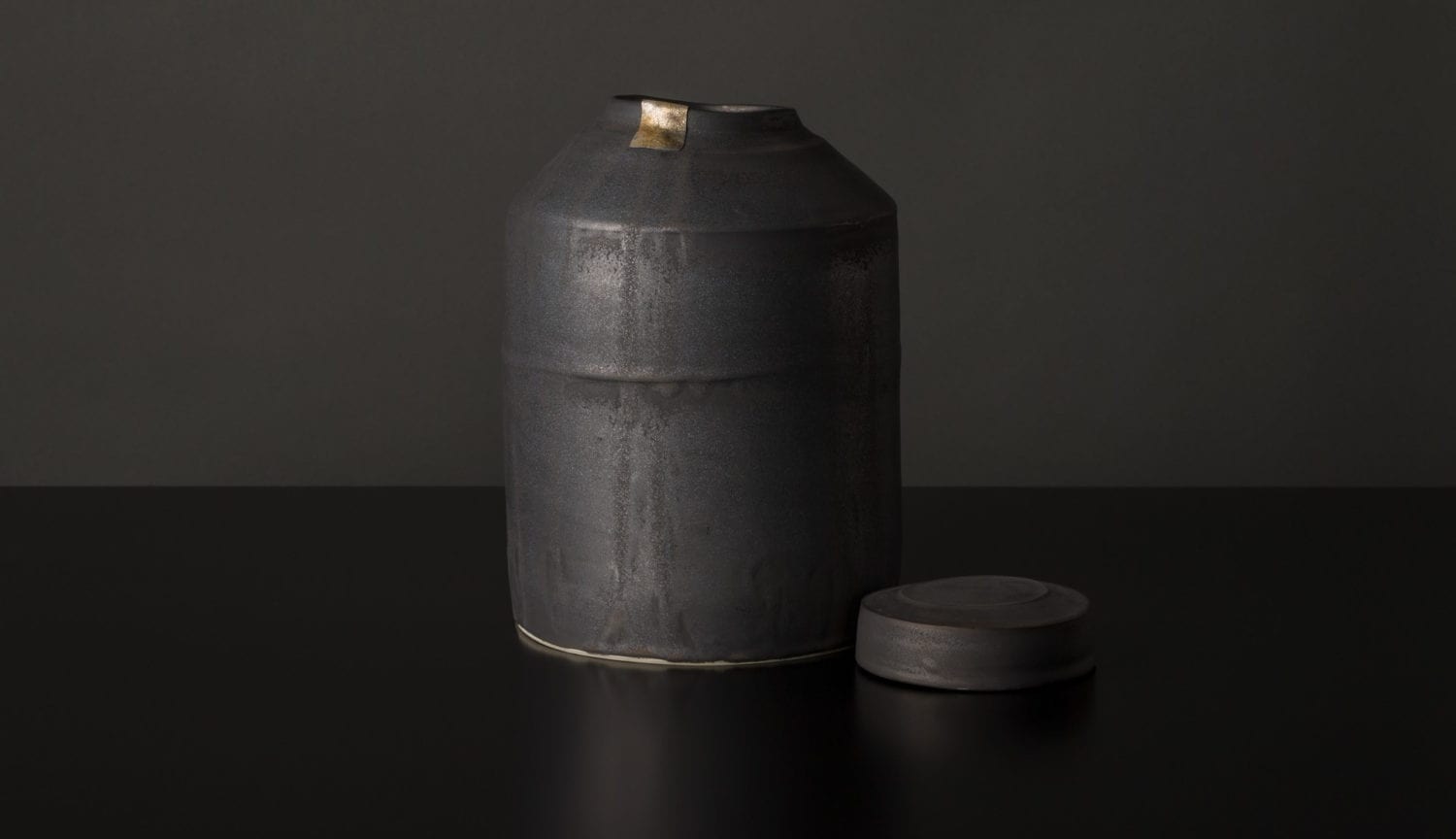

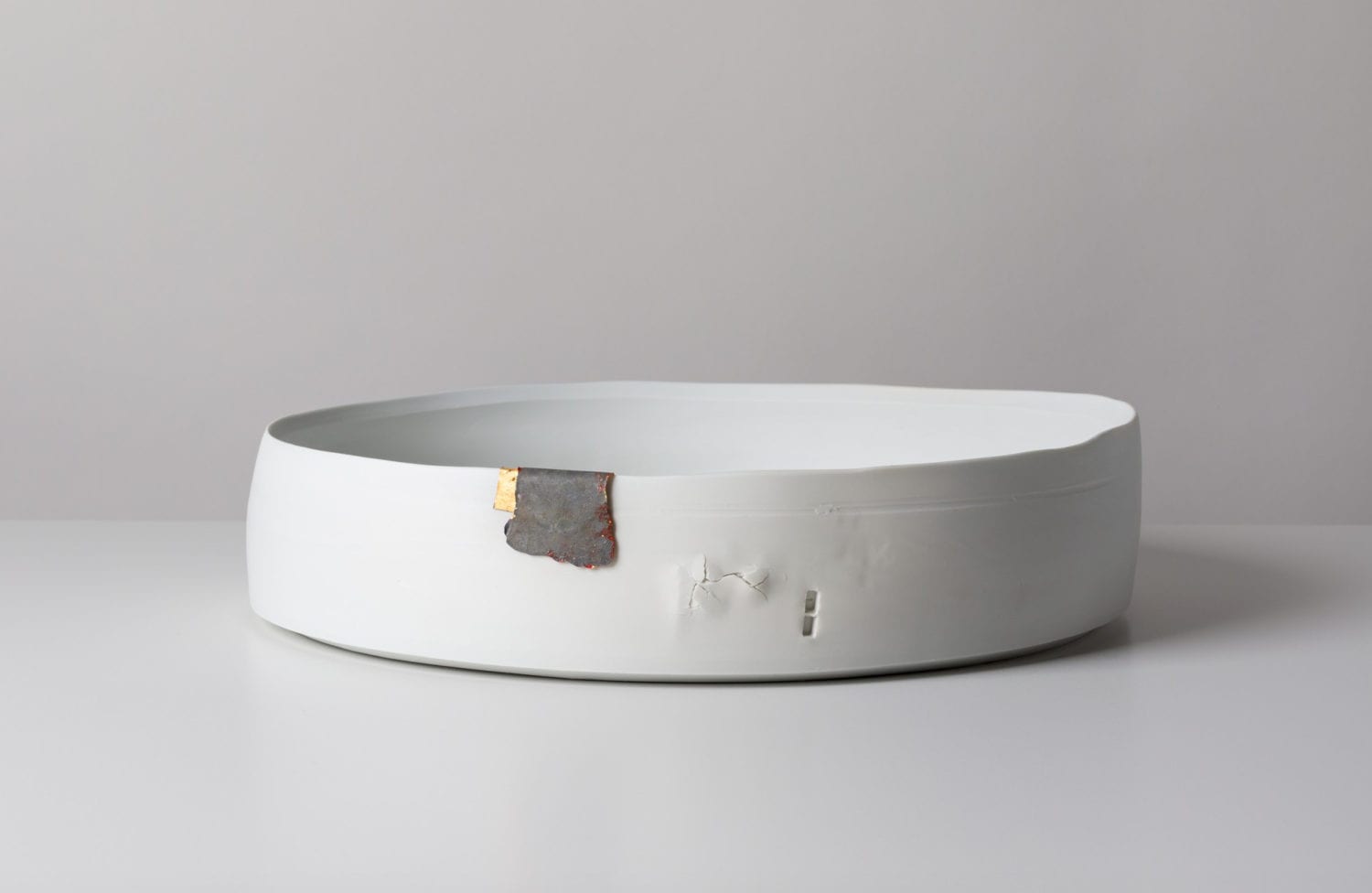

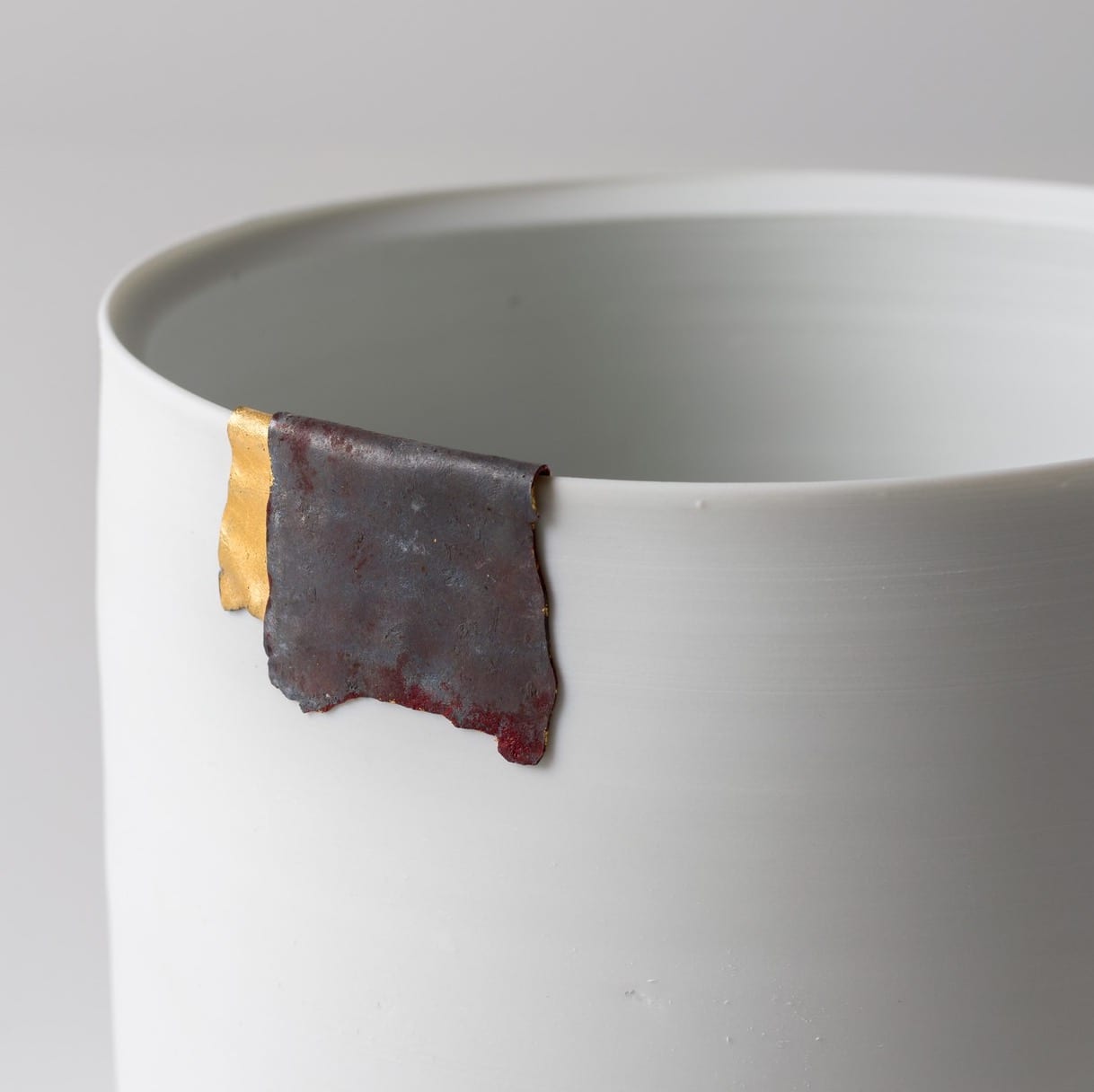

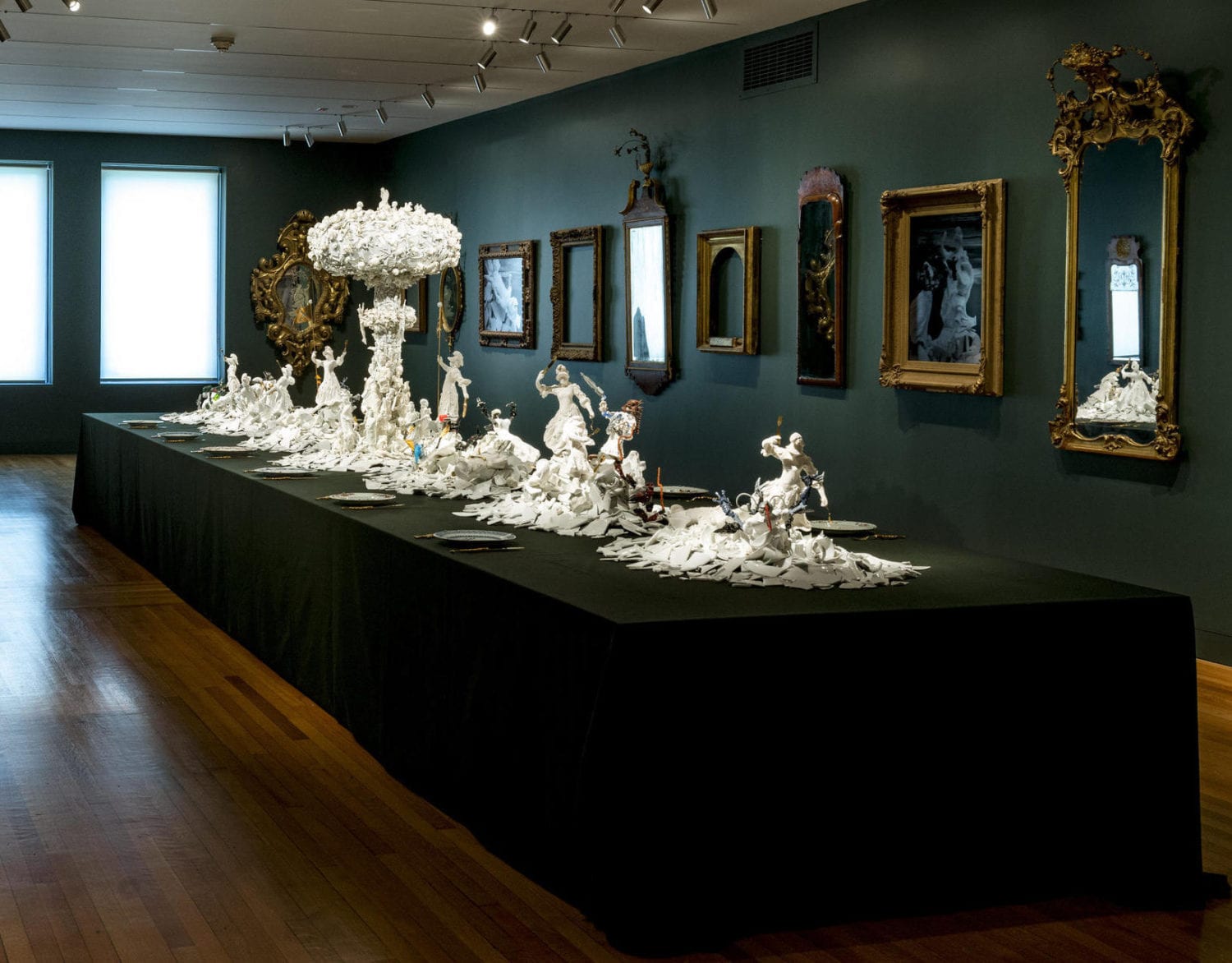
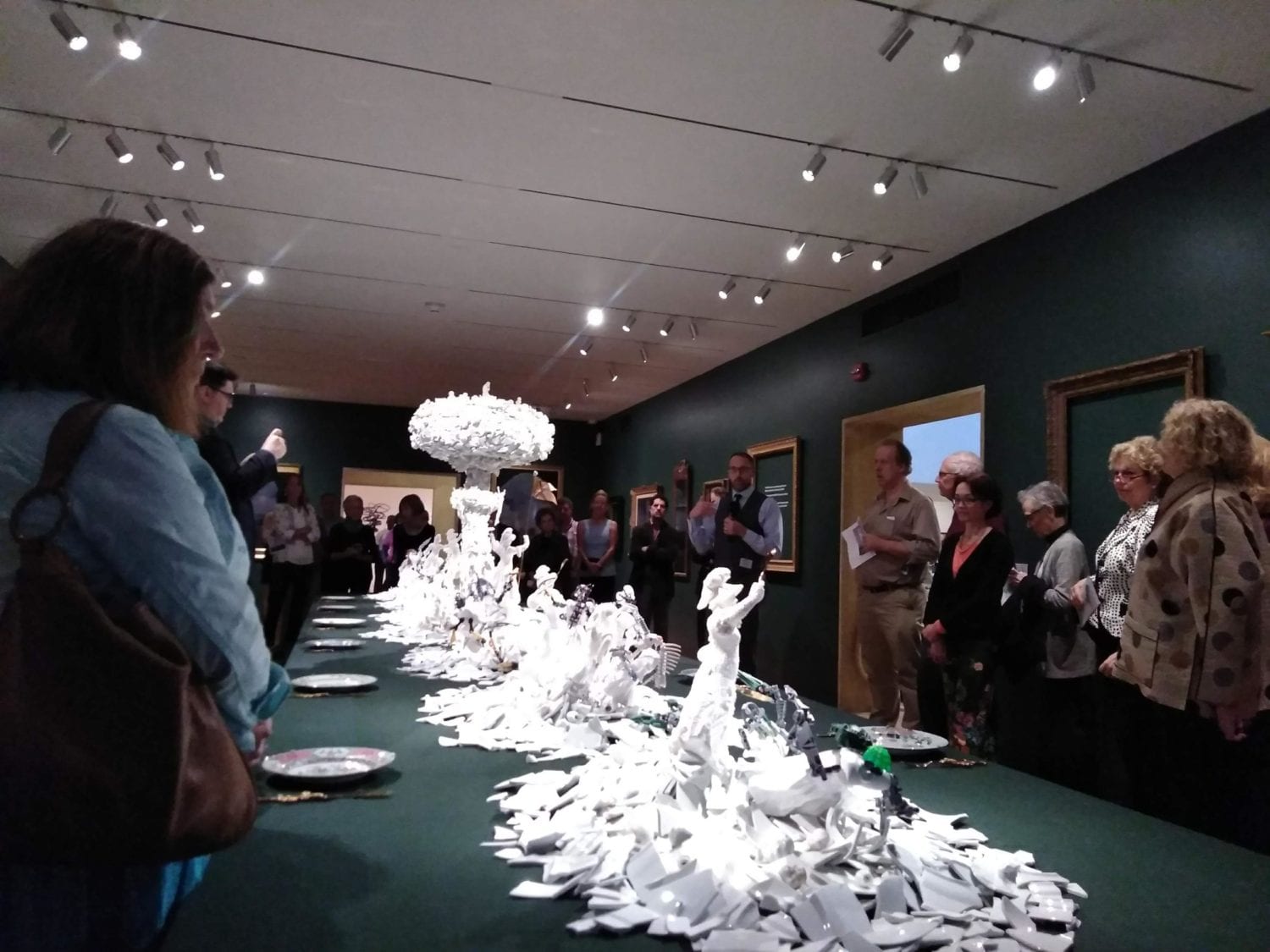

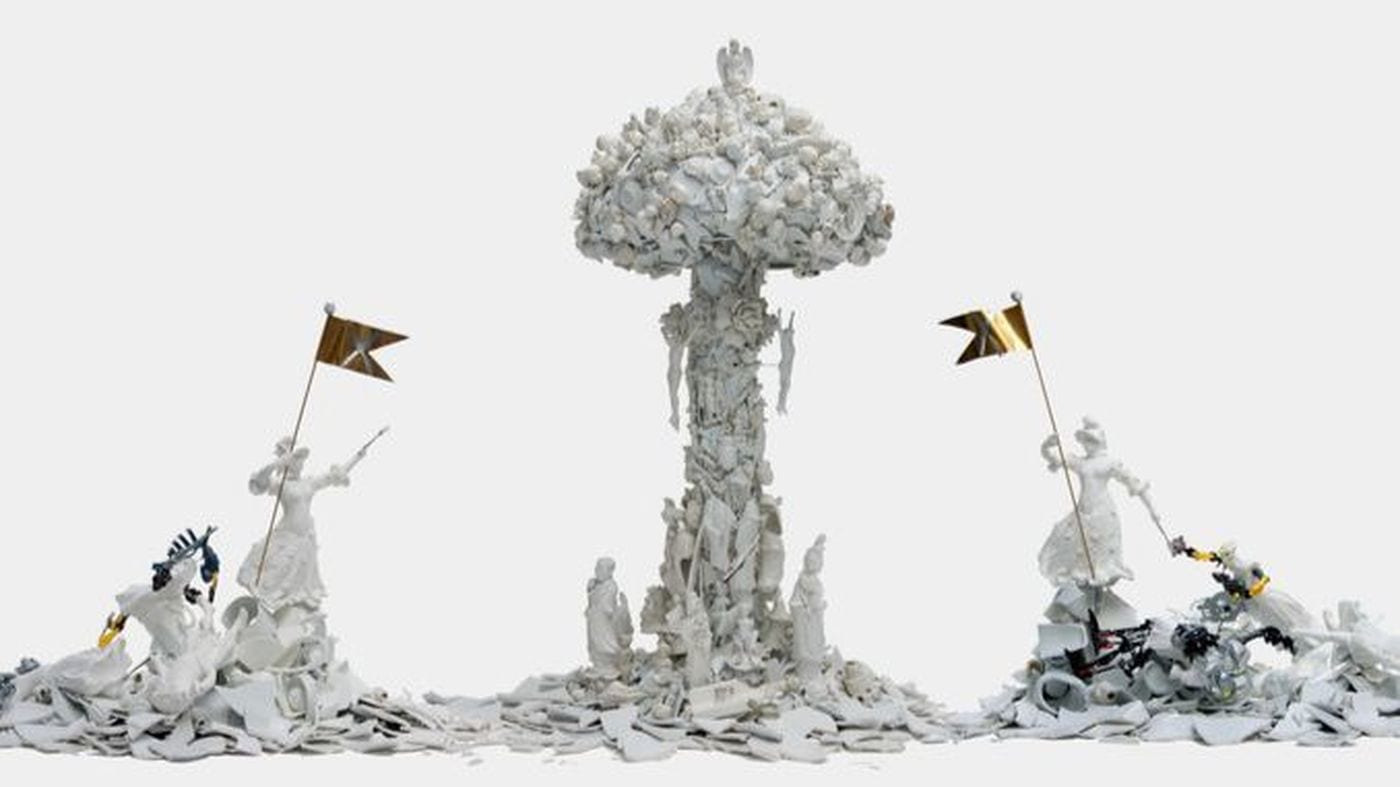
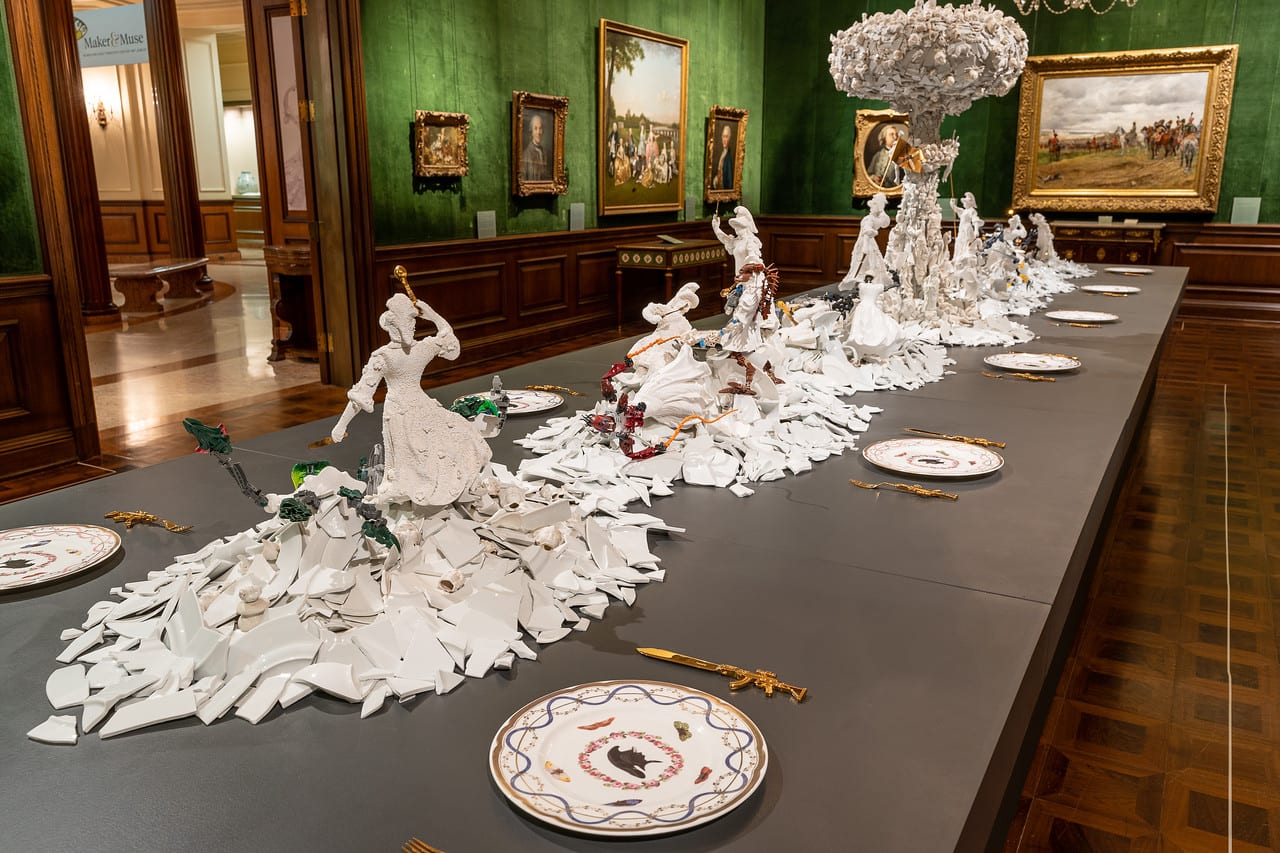
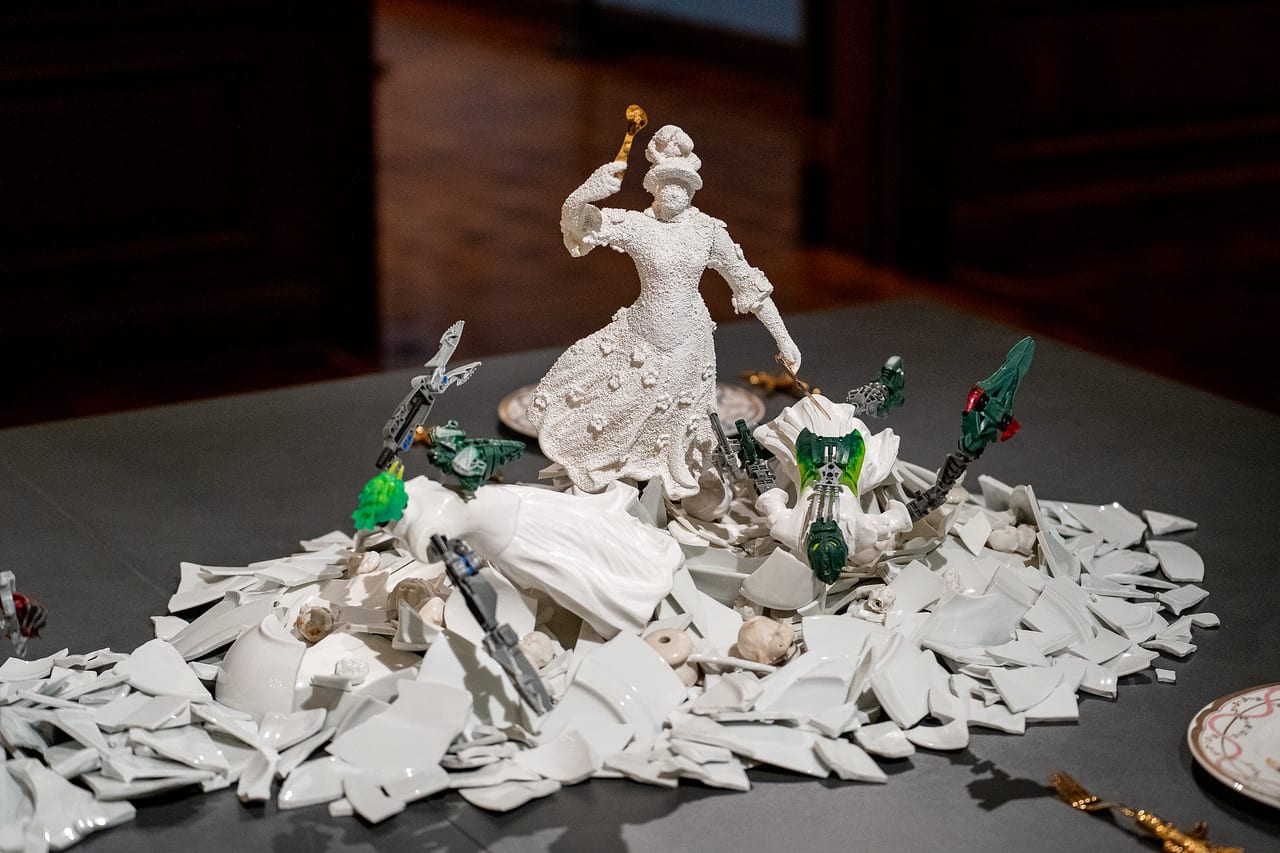
A spectacular assemblage of artists and commentary. So inspiring that I must get to the studio right now!